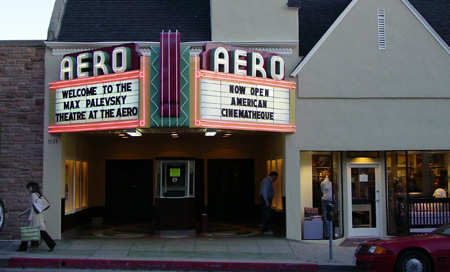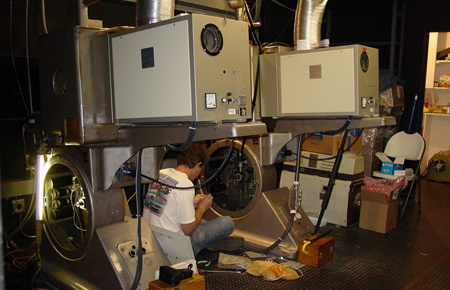Morgenstern On Movies: Taking In the
Big Picture
|
Read more
at in70mm.com The 70mm Newsletter |
| Written by: Joe Morgenstern, Wall Street Journal. Reprinted by written permission from Joe Morgenstern, Wall Street Journal | Date: 31.05.2008 |
 The
Aero cinema in 2006. Image by Paul Rayton The
Aero cinema in 2006. Image by Paul RaytonAfter my usual routine of screenings last week, Friday finally rolled around and I decided to treat myself to a night at the movies. The attraction was a 70mm print of "2001: A Space Odyssey" at the Aero Theater in Santa Monica, an elegantly restored single-screen auditorium, within walking distance of my house, that's run by the American Cinematheque. The first time I saw Stanley Kubrick's masterpiece was at its premiere at the Capitol Theater in New York in 1968. Since then I've probably seen it five or six times, but not again in its original 70mm format until last Friday, which was the start of the Aero's 70mm festival. Having savored the movie's full grandeur way back then, I was eager for the lights to go down and the overture to begin. (The film was made in the road show era, when an important, or self-important, production could be presented with both an overture and an intermission.) First, though, a Cinematheque host welcomed the audience -- the 425-seat house was full -- and asked how many people had ever seen the film projected. Fewer than half raised their hands. He didn't mean projected in 70 mm as opposed to 35 mm, but projected at all, as opposed to displayed on a TV. The audience response suggested how far the movie medium has strayed from the eye-popping, soul-filling images that used to be its stock-in-trade. For most of these moviegoers, Kubrick's universe had been shrunk to fit the dinky dimensions of a home appliance. It would be nice to report that the "2001" screening was an unalloyed triumph, but the host announced that one of the theater's two 70mm projectors had broken down, so reel changes would require additional, albeit brief, intermissions. And the colors weren't pristine, though the print was in better shape than the one shown the following night -- a rare 70mm version of "Apocalypse Now" so obviously faded that the theater, in a touching display of integrity, offered reduced-price admissions. Still, the "2001" audience was supportive from the start -- somehow the news of a technical glitch enhanced the festive mood -- and was rewarded by moments of majesty in stunning detail: the space ship's approach to the rotating space station, accompanied by a Strauss waltz; the psychedelic gateway to another state of being, the dream-like landscapes conjured up by Kubrick and Arthur C. Clarke to represent "infinity and beyond." |
More
in 70mm reading: |
 Assembling
the
DP70s at the Aero in January 2005. Image by Paul Rayton. Assembling
the
DP70s at the Aero in January 2005. Image by Paul Rayton.Here are three films from the mid-1960s that stand up on a giant screen, and also hold up on a small one. Many theaters around the country have 70mm projectors, and periodically show some of the dozens of films originally shot in the wide-screen process -- among them "Lawrence of Arabia," "Patton," "The Sound of Music" and, most recently, Kenneth Branagh's fine 1996 version of "Hamlet." (A reliable list of such screenings can be found, along with all sorts of additional wide-screen info, at in70mm.com). I've written before in this space about the downsizing of the film experience -- the cinema universe shrunk to fit the dimensions of an iPod. The 70mm festival at the Aero (a theater built by the Donald Douglas company to provide round-the-clock movies for aircraft shift workers during World War II) was a reminder of the many experiments in upsizing that have enhanced and enlivened movie history. The most heartening success story, of course, is IMAX, though its screens are notable for their enormity rather than their width. Of the wide-screen formats gone completely or nearly extinct, the most fondly remembered is Cinerama, a process involving three projectors and a vast, three-panel screen that was spectacular in the extreme, but hugely complex, famously balky and subject to image-jiggle at the panels' seams. (I say nearly extinct because a few theaters in the world are still able to show such old Cinerama films as "This Is Cinerama," "Cinerama Holiday" and "How the West Was Won." One of them, Seattle's Cinerama Theater, held a Cinerama festival in 2003, but the management has no plans for a repeat performance in the immediate future.) By now the suffix 'rama' has become part of the language, four letters used to signify sweep, expanse or grandeur. Indeed, the in70mm.com Web site has a page, "All the Ramas In the World," which calls Cinerama "the mother of all 'ramas," and encourages readers to send in examples of its progeny. Responses include the names of restaurants (Restaurama) laundromats (Wash-a-Rama) and businesses (Lumberama, Stylerama, Liquorama, Artarama, Trailerama, Colorama). But the mother is, in fact, a daughter. Here's an example that predates Cinerama by more than a century. In his peerless 1834 novel "Le Père Goriot," Balzac wrote: "The recent invention of the Diorama, carrying optical illusion a stage farther than the Panoramas, had prompted the comic practice in some artists' studios of adding 'rama' to words." This resulted, according to the author, in such neologisms as "healthorama," "souporama" and "cornorama" (as in a corn on a foot). The Diorama, not incidentally, was invented by Louis Daguerre, later of the daguerrotype, and has figured in "The Simpsons," with Springfield Elementary holding a Diorama competition called Diorama-Rama. The impulse to screen grandeur may take odd forms, but it is venerable, and unquenchable. |
|
|
Go: back
- top - back issues
- news index Updated 22-01-25 |
